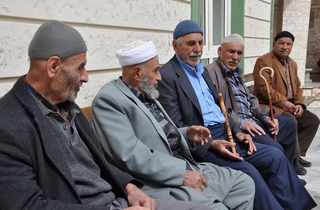According to Turkish Statistics Institute, the number of citizens aged 65 and over has ballooned to 8.7 million in 2023, representing a staggering 21.4% increase from just five years ago (2018). This translates to a remarkable shift in the country's overall population composition, with the proportion of elderly citizens jumping from 8.8% in 2018 to 10.2% in 2023.
Factors Driving the Change
Several factors are contributing to Türkiye's aging population. Advancements in healthcare have led to a longer life expectancy, with the median age in the country rising from 32.0 in 2018 to 34.0 in 2023. Women are particularly benefiting from this trend, with an expected average lifespan 3.5 years longer than men. However, a decline in fertility rates is also playing a crucial role. This trend, if it continues, will further accelerate the aging process in the coming decades.
Demographic Breakdown and Geographic Disparities
A closer look at the elderly population reveals a breakdown by age groups. The majority (64.0%) fall within the 65-74 age range, followed by 28.1% in the 75-84 bracket and a growing segment (7.9%) aged 85 or above. This highlights the potential for a future increase in the need for specialized care services for the very old.
The distribution of the elderly population across Türkiye is not uniform. Provinces like Sinop have the highest percentage (20.0%) of elderly residents, while Şırnak boasts the lowest (3.5%). This disparity suggests a need for targeted policies and resource allocation to address the varying needs of different regions.
Challenges and Considerations
The rapid growth of the elderly population presents several challenges for Türkiye. One key concern is the rising elderly dependency ratio, which currently sits at 15.0%. This ratio indicates the number of elderly individuals per hundred working-age people. As the dependency ratio increases, it places a growing strain on social services and the working population to support the needs of the elderly. Projections suggest this ratio will continue to climb in the coming decades, demanding proactive solutions.
Living Arrangements and Social Fabric
The living arrangements of the elderly population also raise important considerations. Approximately one in four households (24.5%) in Türkiye now has at least one elderly member. This trend signifies a potential shift in family dynamics and caregiving responsibilities.
Furthermore, over 1.6 million elderly individuals live alone, with a higher prevalence among females (74.4%). This statistic underscores the potential need for social support programs and initiatives to combat loneliness and isolation among this vulnerable demographic. Provinces like Balıkesir present a unique challenge with the highest proportion of single-elderly households (34.4%).
Education and Economic Security
While literacy rates among the elderly population are improving (reaching 86.5% in 2022), a significant gender gap persists. Primary school remains the most common education level for this demographic. Investing in educational programs specifically tailored for the elderly could enhance their overall well-being and social participation.
Economic security is another pressing concern. The poverty rate for the elderly population has risen to a concerning 21.7% in 2023, impacting both men and women. Developing targeted social safety nets and exploring opportunities to increase elderly labor force participation are crucial steps to address this issue. Currently, labor force participation among the elderly remains low (12.2% in 2023), with a higher rate for males (20.0%) compared to females (6.1%). The agricultural sector employs the majority (57.7%) of working elderly individuals, highlighting the need for diversification and opportunities in other sectors.
Health Concerns and Technological Inclusion
Obesity rates are a growing concern among the elderly population, with a significant increase observed between 2012 and 2022. Promoting healthy lifestyles and preventative healthcare measures will be essential to address this trend. Heart disease remains the leading cause of death for elderly people (39.1% in 2022), followed by respiratory illnesses and cancer. While Alzheimer's disease deaths are decreasing, they still disproportionately affect women.
On a brighter note, internet usage among the elderly population is growing (40.7% in 2023), with a higher adoption rate among men. This trend can be further encouraged to bridge the digital divide and connect older adults with essential services and information resources. (ILKHA)



 Dünya
Dünya
 Eğitim
Eğitim
 Güncel
Güncel
 Dünya
Dünya
 Güncel
Güncel
 Güncel
Güncel
 Dünya
Dünya
 Güncel
Güncel
 Dünya
Dünya
 Dünya
Dünya





